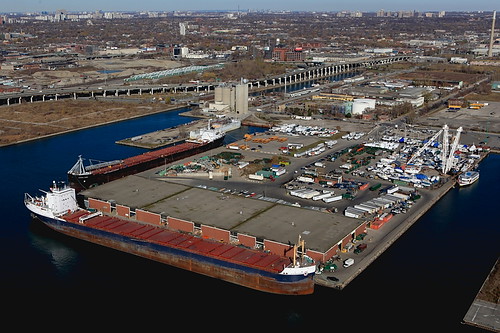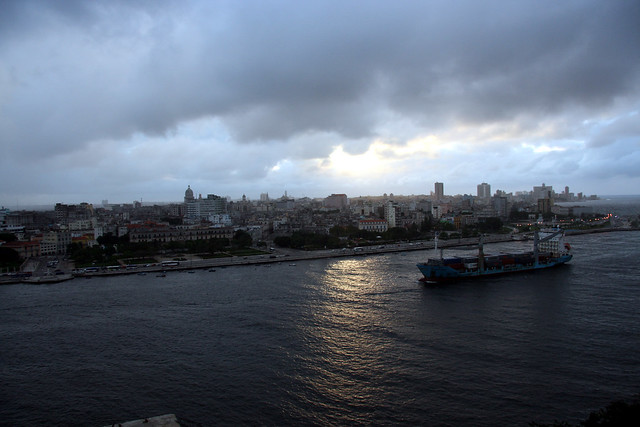The Port of Alexandria is the second most important city and the main seaport for Egypt. The Port of Alexandria stretches for 40 kilometers along a limestone ridge on the shores of the Mediterranean Sea. The Port of Alexandria is about six kilometers northeast of the Port of El-Dekheila, managed by the same port authority, and 26 kilometers west of the Port of Abu Qir. The Port of Alexandria is also about 180 kilometers northwest of Egypt's capital of Cairo. The Port of Alexandria is linked by road, rail, and air to other cities in Egypt and by canal with the Nile River. In 2006, over 4.1 million people lived in the Port of Alexandria's metropolitan area.
The Port of Alexandria's economy is based on the seaport, industrial and commercial activity, and agriculture. Shipping, manufacturing, banking, food processing, and the manufacture of cement and petrochemicals are important to the national economy. The Port of Alexandria makes up about two-fifths of the country's industrial output. The Mina al-Basal area around the Port of Alexandria contains many warehouses. Once home to the Cotton Exchange, the Mina Al-Basal now houses rice and paper mills, asphalt works, salt and tanning factories, a cement works, and an oil refinery. To the south are more oil refineries. Agricultural production is also important to the local economy and, although cotton is not as important as it was in the 19th Century, food production employs many workers in the Port of Alexandria area.
The Port of Alexandria (Al-Iskandariyah) was the greatest city in the ancient world. Now, it's the second largest city and the major seaport for Egypt. Situated at the western edge of the Nile River delta, it's some 180 kilometers northwest of Cairo.
Founded by Alexander the Great in 332 BC, it was the center for Greek science and scholarship until 642 AD when it was conquered by the Arabs. Alexander built the city on the 1500 BC site of Rakotis. When Alexander conquered Tyre in 332 BC, the Port of Alexandria profited from the destruction of the Phoenician's power and from trade with Europe. Many scholars studied there, including Archimedes and Euclid, and the Port of Alexandria was also a center of Jewish scholarship. Upon Alexander's death in 323 BC, rule passed to Pharaoh Ptolemy I who presided over the city's golden age.
The rise of Rome in the 2nd and 1st Centuries BC paralleled the decline of Ptolemaic rule. In fact, the Port of Alexandria was involved in the establishment of imperial Rome. Cleopatra, the last Ptolemy, seduced both Julius Caesar and Marc Antony in her unsuccessful efforts to restore Egyptian power. In 30 BC, Caesar's great-nephew Octavian brought the Port of Alexandria and all of Egypt under Roman rule, including destroying the great Library of Alexandria. Because the Port of Alexandria contained the Egyptian granary that Rome needed, the city regained much autonomy.
Greek culture in the Port of Alexandria began a rapid decline after 415 AD. Alexandria fell to the Persians in 616 AD and to the Arabs in 642 AD. After that time, Alexandrian culture and life reflected the new Muslim faith and culture. Despite declining political influence, the Port of Alexandria continued to be an important trading center for textiles and other luxury goods.
Luckily, the Port of Alexandria came through the early Christian Crusades relatively undamaged, and it played a major role in Egypt's east-west spice trade. However, the discovery of a sea route to India (1498) and Turkey's conquest of Egypt (1517) brought an end to Alexandria's good fortune. By 1798 when Napoleon invaded Egypt, the Port of Alexandria had become a small fishing village.
The Port of Alexandria's rebirth came in 1805 when Muhammad Ali became Ottoman viceroy of Egypt. He sought to modernize Egypt, and he reopened access to the Nile for the Port of Alexandria with the 45-mile Al-Mahmudiyah Canal (1820). He built new docks and an arsenal there between 1828 and 1833, and he located industry in the Port of Alexandria.
After cotton was introduced to Egypt, Europe's hunger for the product brought great wealth to the Port of Alexandria. The Port of Alexandria's importance as a commercial and banking center grew. Then with the American Civil War creating a new cotton boom in the early 1860s and the Suez Canal opening in 1869, the Port of Alexandria enjoyed yet another period of rapid growth.
In 1882, the British occupied the Port of Alexandria to put down local revolt, and they stayed there until 1922. While the British ruled, foreign residents increased to about 100 thousand people, and the city continued to grow. The Port of Alexandria was the Allies' major naval base for the Mediterranean during World War I, and it was almost captured by Axis troops during World War II. The British military finally left the Port of Alexandria in 1946.
In 1952, King Farouk escaped Egypt through the Port of Alexandria. During the 1960s, Alexandria came under the strong control of Egypt's government and was completely "Egyptianized." Abdel Nasser's industrialization effort benefited the Port of Alexandria, particularly in the textile manufacturing and food processing industries.
Egypt's defeat in the 1967 Six-Day War with Israel led to the Port of Alexandria being overwhelmed by trade when the Suez Canal was closed and Egypt evacuated the Canal Zone. Then in 1974, Egypt adopted an open-door trade policy, and the port was again flooded with imported goods.
In the latter 1970s, liberalization and decentralization under Anwar el-Sadat led to the Port of Alexandria's greater financial autonomy and new local pride. Natural gas was discovered, a new iron and steel industry sprang up nearby, oil refineries were updated, a pipeline for crude oil linked the Port of Alexandria of Suez to the Mediterranean near the Port of Alexandria, and a second pipeline linked Cairo to Alexandria. Light industry began to grow there as well.
























